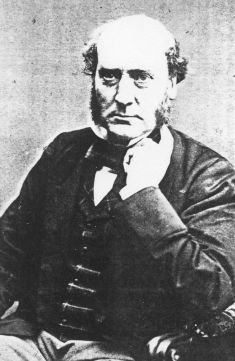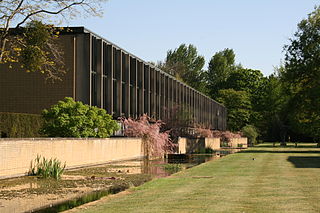
Arne Emil Jacobsen, Hon. FAIA was a Danish architect and furniture designer. He is remembered for his contribution to architectural functionalism and for the worldwide success he enjoyed with simple well-designed chairs.

Sir George Gilbert Scott, largely known as Sir Gilbert Scott, was a prolific English Gothic Revival architect, chiefly associated with the design, building and renovation of churches and cathedrals, although he started his career as a leading designer of workhouses. Over 800 buildings were designed or altered by him.

New College is one of the constituent colleges of the University of Oxford in the United Kingdom. Founded in 1379 by Bishop William of Wykeham in conjunction with Winchester College as New College's feeder school, New College was one of the first colleges in the university to admit and tutor undergraduate students.

St Catherine's College is one of the constituent colleges of the University of Oxford. In 1974, it was also one of the first men's colleges to admit women. It has 528 undergraduate students, 385 graduate students and 37 visiting students as of December 2020, making it one of the largest colleges in either Oxford or Cambridge.

Gloucester Cathedral, formally the Cathedral Church of St Peter and the Holy and Indivisible Trinity and formerly St Peter's Abbey, in Gloucester, England, stands in the north of the city near the River Severn. It originated with the establishment of a minster, Gloucester Abbey, dedicated to Saint Peter and founded by Osric, King of the Hwicce, in around 679.
The year 1902 in architecture involved some significant events.
The year 1964 in architecture involved some significant architectural events and new buildings.
John Oldrid Scott was a British architect.

Sir Arthur William Blomfield was an English architect. He became president of the Architectural Association in 1861; a Fellow of the Royal Institute of British Architects in 1867 and vice-president of the RIBA in 1886. He was educated at Trinity College, Cambridge, where he studied Architecture.

Broad Street is a wide street in central Oxford, England, just north of the former city wall. The street is known for its bookshops, including the original Blackwell's bookshop at number 50, located here due to the University of Oxford. Among residents, the street is traditionally known as The Broad.

Julius Alfred Chatwin FRIBA, ARBS, FSAScot was a British architect. He was involved with the building and modification of many churches in Birmingham, and practised both Neo-Gothic and Neo-Classical styles. His designs always included all of the carvings and internal fittings.

Sir John Ninian Comper was a Scottish architect, one of the last of the great Gothic Revival architects.
William Cecil Marshall was a British architect and amateur tennis player, who was runner-up in the very first Wimbledon tournament to Spencer Gore in 1877. Marshall designed private houses and university buildings in Cambridge, a university building in Dublin, and tennis courts in Cambridge and London, and extended Down House for his friend Charles Darwin. He was an original member of the Art Workers' Guild.

There are 24 Grade I listed buildings in the city of Brighton and Hove, England. The city, on the English Channel coast approximately 52 miles (84 km) south of London, was formed as a unitary authority in 1997 by the merger of the neighbouring towns of Brighton and Hove. Queen Elizabeth II granted city status in 2000.

Danish modern also known as Scandinavian modern is a style of minimalist furniture and housewares from Denmark associated with the Danish design movement. In the 1920s, Kaare Klint embraced the principles of Bauhaus modernism in furniture design, creating clean, pure lines based on an understanding of classical furniture craftsmanship coupled with careful research into materials, proportions, and the requirements of the human body.

The buildings of Nuffield College, one of the colleges of the University of Oxford, are to the west of the city centre of Oxford, England, and stand on the site of the basin of the Oxford Canal. Nuffield College was founded in 1937 after a donation to the University by the car manufacturer Lord Nuffield; he gave land for the college, as well as £900,000 to build and endow it. The architect Austen Harrison, who had worked in Greece and Palestine, was appointed by the University to design the buildings. His initial design, heavily influenced by Mediterranean architecture, was rejected by Nuffield, who called it "un-English" and refused to allow his name to be associated with it. Harrison reworked the plans, aiming for "something on the lines of Cotswold domestic architecture", as Nuffield wanted.

Munkegaard School is a school in Gentofte, just north of Copenhagen, designed by the Danish architect Arne Jacobsen and completed in 1957. The complex is considered to be one of Jacobsen's most important architectural works.

Merseyside is a metropolitan county in North West England. It was created by the Local Government Act 1972, and consists of the metropolitan boroughs of Knowsley, St Helens, Sefton, Wirral, and the city of Liverpool. Buildings are listed on the recommendation of English Heritage to the Secretary of State for Culture, Media and Sport, who makes the decision whether or not to list the structure. Grade I listed buildings are defined as being of "exceptional interest, sometimes considered to be internationally important"; only 2.5 per cent of listed buildings are included in this grade. This is a complete list of Grade I listed churches in the metropolitan county of Merseyside as recorded in the National Heritage List for England.

Queen Anne’s Gate is a street in Westminster, London. Many of the buildings are Grade I listed, known for their Queen Anne architecture. Simon Bradley and Nikolaus Pevsner described the Gate’s early 18th century houses as “the best of their kind in London.” The street’s proximity to the Palace of Westminster made it a popular residential area for politicians; Lord Palmerston was born at No. 20 while Sir Edward Grey and Lord Haldane, senior members of H. H. Asquith’s Cabinet, were near neighbours at Nos. 3 and 28 respectively. Other prominent residents included the philosopher John Stuart Mill at No. 40, Mansfield Smith-Cumming, the founder of MI6 at No. 21, and Admiral “Jacky” Fisher at No. 16.

John Parker was a Welsh cleric and artist. Second son of Thomas Netherton Parker and his wife Sarah Browne of Sweeney Hall, Oswestry, Shropshire, he was educated at Eton College and Oriel College, Oxford. Author of poem "The Passengers: Containing, the Celtic Annals.", published 1831.

















